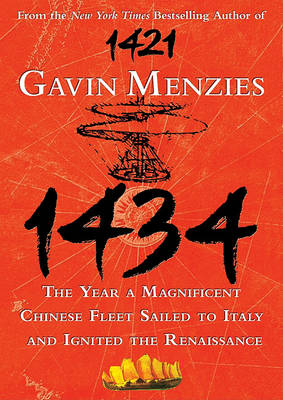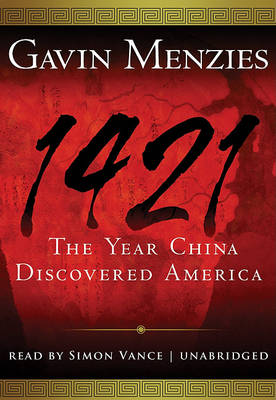P.S.
2 total works
In his bestselling book 1421:The Year China Discovered the World, Gavin Menzies revealed that it was the Chinese that discovered America, not Columbus. Now he presents further astonishing evidence that it was also Chinese advances in science, art, and technology that formed the basis of the European Renaissance and our modern world. In his bestselling book 1421: The Year China Discovered the World, Gavin Menzies presented controversial and compelling evidence that Chinese fleets beat Columbus, Cook and Magellan to the New World. But his research has led him to astonishing new discoveries that Chinese influence on Western culture didn't stop there. Until now, scholars have considered that the Italian Renaissance - the basis of our modern Western world - came about as a result of a re-examining the ideas of classical Greece and Rome. However, a stunning reappraisal of history is about to be published. Gavin Menzies makes the startling argument that a sophisticated Chinese delegation visited Italy in 1434, sparked the Renaissance, and forever changed the course of Western civilization.
After that date the authority of Aristotle and Ptolemy was overturned and artistic conventions challenged, as was Arabic astronomy and cartography. Florence and Venice of the 15th century attracted traders from across the world. Menzies presents astonishing evidence that a large Chinese fleet, official ambassadors of the Emperor, arrived in Tuscany in 1434 where they met with Pope Eugenius IV in Florence. A mass of information was offered by the Chinese delegation to the Pope and his entourage - concerning world maps (which Menzies argues were later given to Columbus), astronomy, mathematics, art, printing, architecture, steel manufacture, civil engineering, military machines, surveying, cartography, genetics, and more. It was this gift of knowledge that sparked the inventiveness of the Renaissance - Da Vinci's inventions, the Copernican revolution, Galileo, etc. Following 1434, Europeans embraced Chinese intellectual ideas, discoveries, and inventions, which formed the basis of European civilization just as much as Greek thought and Roman law. In short, China provided the spark that set the Renaissance ablaze.
After that date the authority of Aristotle and Ptolemy was overturned and artistic conventions challenged, as was Arabic astronomy and cartography. Florence and Venice of the 15th century attracted traders from across the world. Menzies presents astonishing evidence that a large Chinese fleet, official ambassadors of the Emperor, arrived in Tuscany in 1434 where they met with Pope Eugenius IV in Florence. A mass of information was offered by the Chinese delegation to the Pope and his entourage - concerning world maps (which Menzies argues were later given to Columbus), astronomy, mathematics, art, printing, architecture, steel manufacture, civil engineering, military machines, surveying, cartography, genetics, and more. It was this gift of knowledge that sparked the inventiveness of the Renaissance - Da Vinci's inventions, the Copernican revolution, Galileo, etc. Following 1434, Europeans embraced Chinese intellectual ideas, discoveries, and inventions, which formed the basis of European civilization just as much as Greek thought and Roman law. In short, China provided the spark that set the Renaissance ablaze.
On 8 February 1421 the largest fleet the world had ever seen sailed from its base in China. The ships, 500 foot long junks made from the finest teak and mahogany, were led by Emperor Zhu Di's loyal eunuch admirals. Their mission was "to proceed all the way to the end of the earth to collect tribute from the barbarians beyond the seas" and unite the whole world in Confucian harmony. Their journey would last over two years and circle the entire globe. When they returned Zhu Di had fallen from power and China was beginning its long, self-imposed isolation from the world it had so recently embraced. The great ships rotted at their moorings and the records of their journeys were destroyed. Lost was the knowledge that Chinese ships had reached America 70 years before Columbus and circumnavigated the globe a century before Magellan. They has also discovered Antarctica, reached Australia 350 years before Cook and solved the problem of longitude 300 years before the Europeans. Gavin Menzies has spent 15 years tracing the astonishing voyages of the Chinese fleet. In this historical detective story, he shares the account of his discoveries and the incontrovertible evidence to support them.
His narrative brings together ancient maps, precise navigational knowledge, astronomy and the surviving accounts by Chinese explorers and the later European navigators. It brings to light the artefacts and inscribed standing stones left behind by the Emperor's fleet, the evidence of sunken junks along its route and the ornate votive offerings left by the Chinese sailors wherever they landed, in thanks to Shao Lin, goddess of the sea.
His narrative brings together ancient maps, precise navigational knowledge, astronomy and the surviving accounts by Chinese explorers and the later European navigators. It brings to light the artefacts and inscribed standing stones left behind by the Emperor's fleet, the evidence of sunken junks along its route and the ornate votive offerings left by the Chinese sailors wherever they landed, in thanks to Shao Lin, goddess of the sea.

